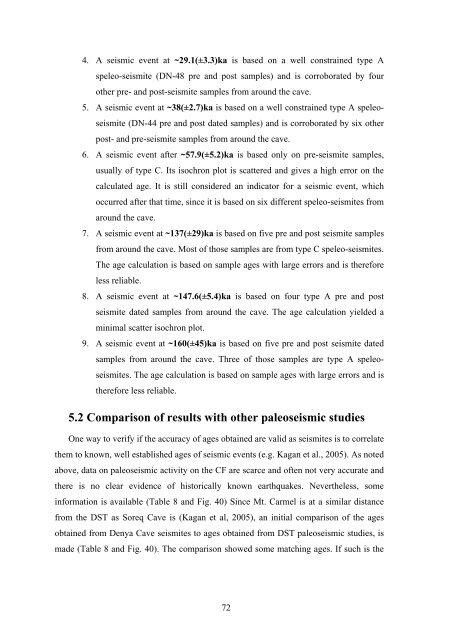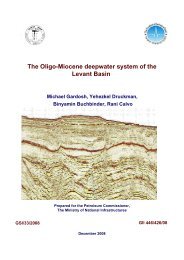tivity on the carmel faul
tivity on the carmel faul
tivity on the carmel faul
Create successful ePaper yourself
Turn your PDF publications into a flip-book with our unique Google optimized e-Paper software.
4. A seismic event at ~29.1(±3.3)ka is based <strong>on</strong> a well c<strong>on</strong>strained type A<br />
speleo-seismite (DN-48 pre and post samples) and is corroborated by four<br />
o<strong>the</strong>r pre- and post-seismite samples from around <strong>the</strong> cave.<br />
5. A seismic event at ~38(±2.7)ka is based <strong>on</strong> a well c<strong>on</strong>strained type A speleoseismite<br />
(DN-44 pre and post dated samples) and is corroborated by six o<strong>the</strong>r<br />
post- and pre-seismite samples from around <strong>the</strong> cave.<br />
6. A seismic event after ~57.9(±5.2)ka is based <strong>on</strong>ly <strong>on</strong> pre-seismite samples,<br />
usually of type C. Its isochr<strong>on</strong> plot is scattered and gives a high error <strong>on</strong> <strong>the</strong><br />
calculated age. It is still c<strong>on</strong>sidered an indicator for a seismic event, which<br />
occurred after that time, since it is based <strong>on</strong> six different speleo-seismites from<br />
around <strong>the</strong> cave.<br />
7. A seismic event at ~137(±29)ka is based <strong>on</strong> five pre and post seismite samples<br />
from around <strong>the</strong> cave. Most of those samples are from type C speleo-seismites.<br />
The age calculati<strong>on</strong> is based <strong>on</strong> sample ages with large errors and is <strong>the</strong>refore<br />
less reliable.<br />
8. A seismic event at ~147.6(±5.4)ka is based <strong>on</strong> four type A pre and post<br />
seismite dated samples from around <strong>the</strong> cave. The age calculati<strong>on</strong> yielded a<br />
minimal scatter isochr<strong>on</strong> plot.<br />
9. A seismic event at ~160(±45)ka is based <strong>on</strong> five pre and post seismite dated<br />
samples from around <strong>the</strong> cave. Three of those samples are type A speleoseismites.<br />
The age calculati<strong>on</strong> is based <strong>on</strong> sample ages with large errors and is<br />
<strong>the</strong>refore less reliable.<br />
5.2 Comparis<strong>on</strong> of results with o<strong>the</strong>r paleoseismic studies<br />
One way to verify if <strong>the</strong> accuracy of ages obtained are valid as seismites is to correlate<br />
<strong>the</strong>m to known, well established ages of seismic events (e.g. Kagan et al., 2005). As noted<br />
above, data <strong>on</strong> paleoseismic ac<str<strong>on</strong>g>tivity</str<strong>on</strong>g> <strong>on</strong> <strong>the</strong> CF are scarce and often not very accurate and<br />
<strong>the</strong>re is no clear evidence of historically known earthquakes. Never<strong>the</strong>less, some<br />
informati<strong>on</strong> is available (Table 8 and Fig. 40) Since Mt. Carmel is at a similar distance<br />
from <strong>the</strong> DST as Soreq Cave is (Kagan et al, 2005), an initial comparis<strong>on</strong> of <strong>the</strong> ages<br />
obtained from Denya Cave seismites to ages obtained from DST paleoseismic studies, is<br />
made (Table 8 and Fig. 40). The comparis<strong>on</strong> showed some matching ages. If such is <strong>the</strong><br />
72

















